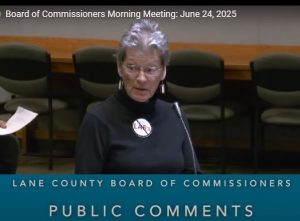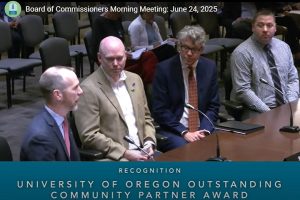April 2022 is ‘Preserving and Protecting Local News Month’
6 min read
Washington, D.C. – U.S. Senator Ron Wyden joined colleagues this week in introducing a resolution to support the designation of April 2022 as “Preserving Local News Month.”
The resolution recognizes local news as a public good that serves an essential function in the democracy of the United States.
“As the son of a journalist, I am proud to introduce legislation recognizing the importance of local news in our democracy,” said Wyden, who also has introduced the Local Journalism Sustainability Act. “I will keep fighting tooth-and-nail to help Oregon newsrooms recover from the pandemic and preserve the public service local news provides to our communities.”
According to recent research, the overall employment in newspaper, television, radio, and digital newsrooms in the United States fell by 26 percent, or 30,000 jobs, from 2008-2020. More than 100 local newsrooms were forced to close during the COVID-19 pandemic, with 30 percent of local television stations reporting budget cuts and staff reductions.
The resolution affirms the significance of local news in increasing civic engagement and strengthening democratic norms and practices, and acknowledges the valuable contributions of local journalism towards the maintenance of healthy and vibrant communities.
The full text states:
Whereas the United States was founded on the principle of freedom of the press enshrined in the First Amendment to the Constitution of the United States, which declares that “Congress shall make no law . . . abridging the freedom of speech, or of the press . . .”;
Whereas an informed citizenry depends on accurate and unbiased news reporting to inform the judgment of the people;
Whereas a robust, diverse, and sustainable local news presence leads to civic engagement and the buttressing of democratic norms and practices;
Whereas local news serves as a necessary resource during the COVID-19 pandemic to provide communities with public health information and to inform communities about available services and support from Federal, State, local, Tribal, and territorial governments;
Whereas published guidance from the Department of Homeland Security deemed journalists as essential critical infrastructure workers during the COVID-19 pandemic;
Whereas the absence of local news outlets and investigative reporting allows local government corruption and corporate malfeasance to go unchecked;
Whereas local journalists help combat disinformation by using their community knowledge and connections to debunk fraudulent or misleading content;
Whereas local cable franchises routinely provide for public educational and government access channels on their systems, and those channels—
- Offer vital local civic programming that informs communities;
- Provide news and information not often available on other local broadcast channels or cable;
- Supplement local journalism; and
- At times, are the only source for local news;
Whereas the people of the United States trust local news sources by a 2-to-1 margin;
Whereas, according to recent research—
- The United States has lost more than 2,100 local print outlets since 2004;
- More than 200 counties in the United States have no newspaper at all, creating a news shortage for the 3,200,000 residents of those counties;
- Of the remaining counties in the United States, more than half, or 1,528, have only 1 newspaper to cover populations ranging from under 1,000 to more than 1,000,000 residents;
- More than half of all United States newspapers have changed owners in the past decade, and, in 2018, only 25 companies owned two-thirds of all daily newspapers;
- Of the surviving 6,700 newspapers in the United States, at least 1,000 qualify as ‘‘ghost newspapers’’, or newspapers with reporting and photography staffs that are so significantly reduced that they can no longer provide much of the breaking news or public service journalism that once informed readers about vital issues in their communities; and
- Rural counties are among the counties most deeply impacted by the loss of local reporting, as more
than 500 of the 2,100 newspapers that have closed or merged since 2004 are in rural counties;
Whereas, while overall employment in newspaper, television, radio, and digital newsrooms dropped by roughly 26 percent, or 30,000 jobs, between 2008 and 2020, the plunge in newspaper newsrooms alone was much worse at 57 percent, or 40,000 jobs, in that same time period;
Whereas the number of news employees in the radio broadcasting industry dropped by 22 percent between 2004 and 2020;
Whereas beat reporting, meaning the day-to-day coverage of a particular field that allows a journalist to develop expertise and cultivate sources, has ceased to be a viable career for would-be journalists due to the decimation of newsroom budgets;
Whereas requests submitted under section 552 of title 5, United States Code (commonly referred to as ‘‘Freedom of Information Act requests’’), by local newspapers to local, State, and Federal agencies fell by nearly 50 percent between 2005 and 2010, demonstrating a significant drop in the extent to which local reporters request government records;
Whereas newspapers alone lost more than $35 billion in advertising revenue between 2004 and 2018;
Whereas, in the second quarter of 2020, advertising revenue fell by a median of 24 percent for local television companies;
Whereas the revenue of all-news radio stations dropped by 24 percent in 2020;
Whereas there remains a significant gender disparity in newsroom employment, with women comprising approximately one-third of staff who are 30 years of age or older;
Whereas women who are local television news anchors and reporters, especially women of color, are often subject to harassment and stalking;
Whereas, across the United States, there are more than 200 newspapers published by and for Black readers, and, in recent years, many of those newspapers have seen—
- Significant losses in advertising revenue as small businesses in their communities were forced to close; and
- Circulation declines due to the closures of businesses in their communities;
Whereas the number of Black journalists working at daily newspapers dropped by 40 percent between 1997 and 2014, more than for any other demographic group;
Whereas the number of print media sources published by and for American Indian readers has shrunk dramatically in recent years, from 700 media outlets in 1998 to only 200 in 2018;
Whereas Tribally-owned news outlets are often dependent on Tribal governments for funding, but most of those outlets lack the policy structure necessary to fully protect journalistic independence;
Whereas a 2018 survey by the Native American Journalists Association found that 83 percent of respondents believed that Native press coverage of Tribal government affairs was sometimes, frequently, or always censored;
Whereas there are more than 550 Latino news media outlets in the United States, which rely primarily on a declining advertising revenue base;
Whereas the lack of local news impacts communities that speak languages other than English, which are often excluded from national media coverage;
Whereas more than 100 local newsrooms have closed during the COVID-19 pandemic;
Whereas 8 percent of surveyed local radio stations reported the COVID-19 pandemic ended their local news programs entirely;
Whereas 30 percent of local television news stations reported budget cuts and staff reductions because of the COVID19 pandemic;
Whereas PEN America proposed “a major reimagining of the local news space” in its 2019 call-to-action report, Losing the News: The Decimation of Local Journalism and the Search for Solutions, and called on society and the Federal Government to urgently address the alarming demise of local journalism; and
Whereas, half a century ago, Congress perceived that the commercial television industry would not independently provide the educational and public interest broadcasting that was appropriate and necessary for the country, and, informed by an independent report prepared by the Carnegie Commission on Educational Television, created the Corporation for Public Broadcasting, which has since ensured that radio and television include public interest educational and reporting programs using annually appropriated funds:
Now, therefore, be it resolved, That the Senate—
- Designates April 2022 as “Preserving and Protecting Local News Month”;
- Affirms that local news serves an essential function in the democracy of the United States;
- Recognizes local news as a public good; and
- Acknowledges the valuable contributions of local journalism towards the maintenance of healthy and vibrant communities.
The resolution is endorsed by the Alliance for Community Media, California Black Media, Common Cause, Corporation for Public Community Newspapers, Free Press Action, National Association of Black Journalists (NABJ), National Press Photographers Association (NPPA), Native American Journalists Association (NAJA), Online News Association, PEN America, Public Knowledge, Society of Professional Journalists, Theatre Communications Group, Writers Guild of America, East, AFL-CIO, National Association of Hispanic Journalists (NAHJ), United Church of Christ Media Justice Ministry, National Newspaper Association, Department for Professional Employees, AFL-CIO, The NewsGuild – Communications Workers of America (TNG-CWA), and National Writers Union.




